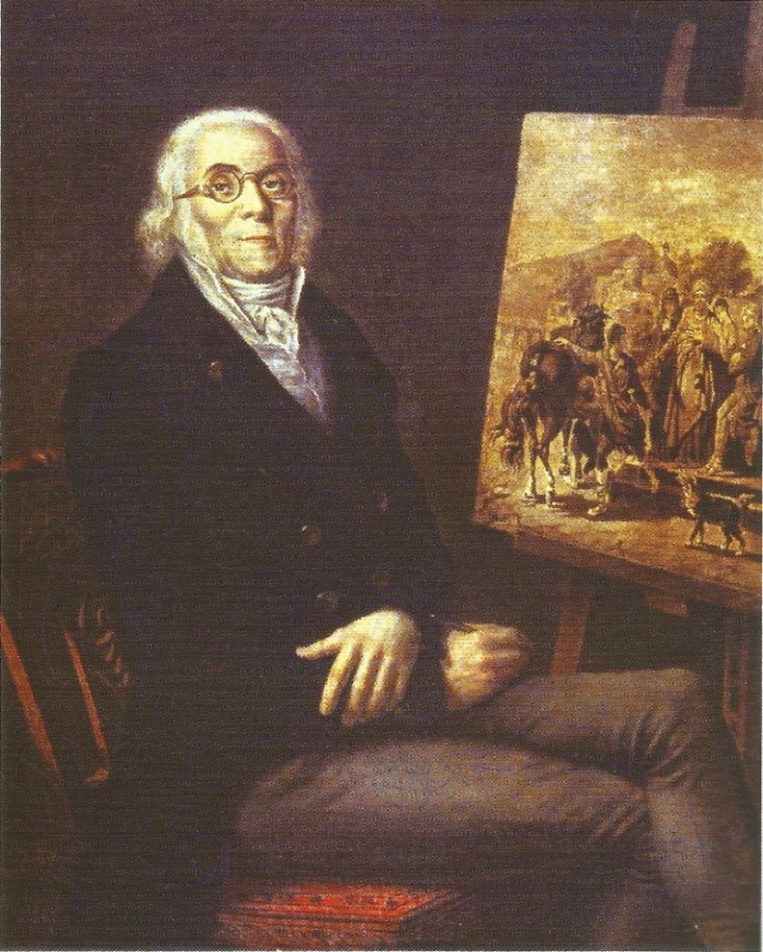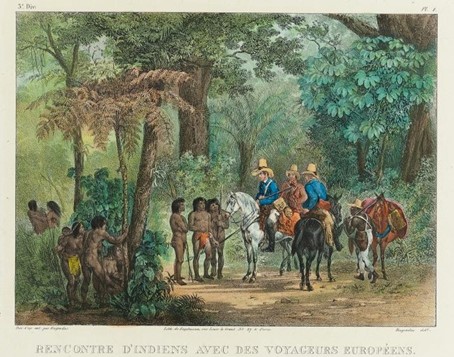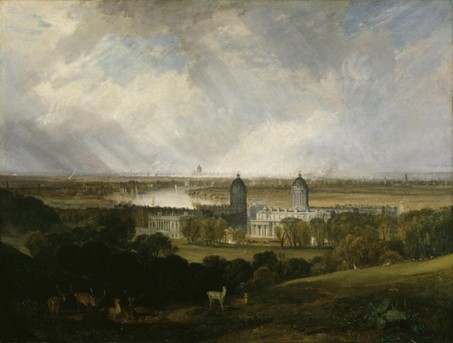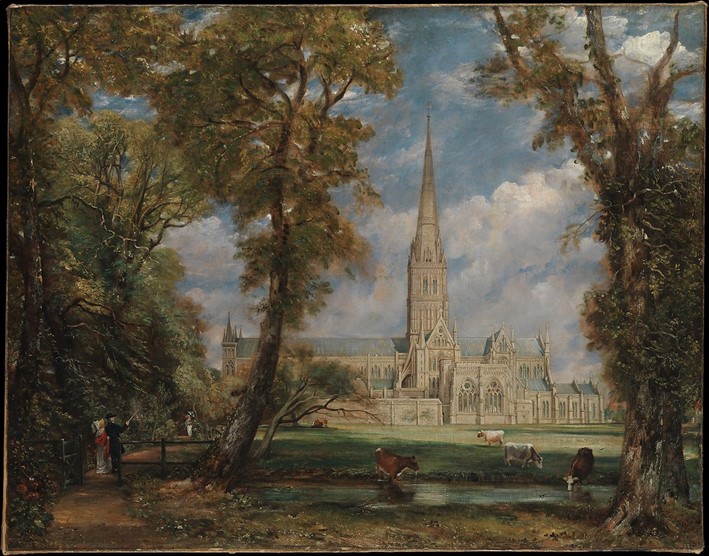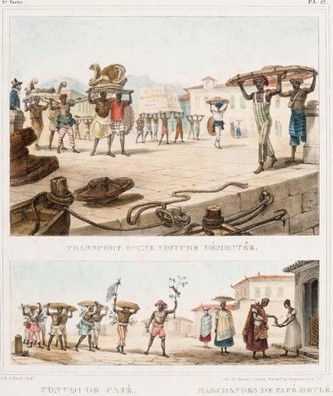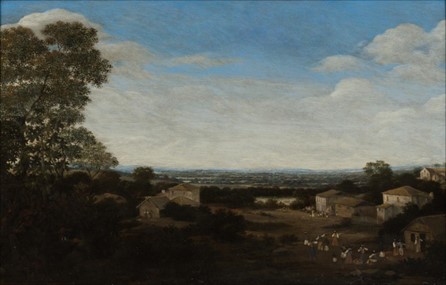Politic Iconography: The Sky and Pants of Nicolas-Antoine Taunay (1755-1830)
- Autora | Bárbara Dantas
- 6 de jul. de 2023
- 22 min de leitura
Bárbara Dantas[1]
* Se precisar citar, tê-lo como referência, seguir:
DANTAS, Bárbara. Politic Iconography: The Sky and Pants of Nicolas-Antoine Taunay (1755-1830). World Academy of Science, Engineering and Technology [Humanities and Social Sciences], jul. 2023. Disponível em: https://www.barbaradantas.com/post/politic-iconography-the-sky-and-pants-of-nicolas-antoine-taunay-1755-1830
Resumo: Nicolas-Antoine Taunay tinha tudo para ter uma vida sossegada junto a sua numerosa família, seus colegas da Academia de Arte de Paris e como renomado pintor, mas, a conjuntura foi deveras complicada. O pintor francês teve que se desdobrar para dar conta de diversas rupturas políticas e sociais: da realeza à revolução francesa, do império de Napoleão Bonaparte ao império português. Este trabalho, portanto, deseja inserir Taunay naquele contexto por meio da análise de sua representação em um retrato feito por um colega de profissão, Julien Léopold Boilly, e em uma paisagem brasileira pintada por ele mesmo. Enfim, a intenção é encontrar nestas duas pinturas como Nicolas-Antoine Taunay encarou a si e ao meio que o rodeava naquele trânsito que foi obrigado a fazer entre Paris e o Rio de Janeiro.
Palavras-chave: Nicolas-Antoine Taunay, iconografia política, arte francesa, arte brasileira, século XIX.
Resumen: Nicolas-Antoine Taunay lo tenía todo para tener una vida tranquila con su numerosa familia, sus colegas de la Academia de Arte de París y como pintor de renombre, pero la situación era realmente complicada. El pintor francés tuvo que hacer todo lo posible para hacer frente a diversas rupturas políticas y sociales: de la realeza a la revolución francesa, del imperio de Napoleón Bonaparte al imperio portugués. Esta obra, por tanto, pretende insertar a Taunay en ese contexto a través del análisis de su representación en un retrato realizado por un colega profesional, Julien Léopold Boilly, y en un paisaje brasileño pintado por él mismo. Finalmente, la intención es encontrar en estos dos cuadros cómo Nicolas-Antoine Taunay se enfrentó a sí mismo y a su entorno en ese tránsito que se vio obligado a hacer entre París y Río de Janeiro.
Palavras-clave: Nicolas-Antoine Taunay, iconografía política, arte francés, arte brasileño, siglo XIX.
Abstract: Nicolas-Antoine Taunay had everything to have a quiet life with his family, his colleagues from the Paris Academy of Art, and as a renowned painter of the French Court, but the conjuncture was quite complicated in those final years of the eighteenth century and first decades of the 19th century. The painter had to adapt to various political and social ruptures: from royalty to the French Revolution, from the empire of Napoleon Bonaparte to the empire of King John VI. We wish to insert Taunay in its context through the analysis of his portrait made by a colleague of the profession and of a Brazilian landscape painted of his own (1816-1821) and, in which he represented himself. Finally, the intention is to find in these two paintings how Nicolas-Antoine Taunay faced himself and in the middle that surrounded him in the traffic that was forced to make it between Paris and Rio de Janeiro.
Keywords: Nicolas-Antoine Taunay, politic iconography, French Art, Brazilian Art, 19th century.
I. Introduction
It is the posterity that exalts or ignores a historical period, fact or character. This was the case with the arrival of the Portuguese Royal Family to America in 1808. Due to the peculiarity of the facts (French Revolution, Napoleonic invasions, the Portugal court in Brazil etc.) and the characters involved (the Bonaparte couple, d. Carlota Joaquina and d. João among others), from time to time, this period gains the attention of researchers and the public. Nicolas-Antoine Taunay (1755-1830) was contemporary with these events and related to these characters.
The Joanine Period (1808-1821) is known as such due to the time when the Portuguese sovereign, d. João, lived in the city of Rio de Janeiro. In [1], published in the year of the Bicentenary of the arrival of the Portuguese royal family to Brazil (1808-2008), the researcher introduces the reader to Nicolas-Antoine Taunay, a French painter who arrived in Brazil in 1816 with a group of professional colleagues to serve in the Court of d. João, a group that became known as the French Artistic Mission, although there are still doubts about the historical validity of this nomenclature.
For Fernand Braudel (1902-1985) [2], protecting the arts or an artist was an effective form of display of power and, therefore, the great were willing to play the role of patron. Despite the religious orthodoxy and aversion to the Enlightenment and the Revolution of the French, in the first two decades of the 19th century, the Portuguese government installed in the capital of its American colony, Rio de Janeiro, was a space of openness to the arts.
As for the analysis of the artist's painting, the Catalogue Raisonnée published in 2003 by the French researcher Claudine Lebrun Jouve is still the main work with information about the life and work of Nicolas-Antoine Taunay. It is a compendium of all the artist's works, from his first works, still in his youth, to works whose whereabouts are unknown, but fortunately, registered. From the analysis of this set of visual sources of the painter, it is possible to get closer to his aesthetic ideal, rules of composition, shapes, colors, in addition to the sociopolitical background that underlie all of them [3].
We used the common method among researchers who study the image-text relationship, in particular the iconographic analysis method formulated by [4]. The intention is to demonstrate how the work of art has a social and political meaning, in addition to its aesthetic and artistic importance. To support these examinations, we resorted to the line of research based on the long historical duration of the French art theorist Georges Didi-Huberman [5]-[7], in addition to the concept of political iconography proposed by the Italian micro historian Carlo Ginzburg [8], and court culture by the German sociologist Norbert Elias (1897-1990) [9].
II. The Artist
The distinguished gentleman of Fig. 1 with already white hair and wearing glasses is Nicolas-Antoine Taunay, the French artist on who this article will lean. His scathing, sure and noble posture demonstrates that he has not yielded to the brio of his condition; knew the value of his strain and his artwork; in addition to emphasizing his relationship with nobility and royalty, his main patrons.
In 18th-century Europe, unlike some kingdoms - and perhaps more than all - France has devoted a special appreciation to the Arts. After all, what would be of the imaginary around the Ancien Régime - of the absolutist kings and their courts - without the visual records made by artists who willingly submitted to the norms of the social group that made the image their greatest ally as maintainer of political power? In this case, just as some French historians of that period were known as "narrative specialists" and their craft was to "fabricate the image" of the king and the noble, the contemporary painters to them were experts in "visual narratives", that is, in "creating images" of these same kings and members of their Court [10] (translation: Bárbara Dantas).
Fig. 1 Julien Léopold Boilly (1796-1874), Nicolas-Antoine Taunay, c. 1825, oil on canvas, Castro Maya Museum - Rio de Janeiro [1]
The value of his profession, that is, that of painter, is noted in Fig. 1. This is visible in the palette in your hand and on the screen that is in front of you. In the Arts, the name of these iconographic elements present in paintings are "attributes", a concept used by Erwin Panofsky (1892-1968). The attributes show the insignia of the central figure and can symbolize various things, from his social position, through his chimeras, to reaching his craft [4]. As for Taunay's portrait, it is enough to "look at it truly" (translation: Bárbara Dantas), so teaches us another theorist of the Arts, Georges Didi-Huberman [5]. In this involvement between Art and History, let's look at the analysis of François Fénelon (1651-1715), a French historian, in his Projet d'un traité sur l'histoire (1714), in which he asserted that the historian and painter seek the same things, showing the truth and customs:
Le point le plus necessaire et le plus rare pour un historien, est qu'il sache exactement la forme du gouvernement et le détail des moeurs de la nation dont il écrit l'histoire, pour chaque siècle. Un peintre qui ignora ce qu'on nomme 'il costume' ne peint rien avec verité [11].
The most necessary and rare point for a historian is that he knows exactly the form of government and the details of the customs of the nation whose history he writes, for each century. A painter who ignores what is called 'custom' paints nothing with truth (translation: Bárbara Dantas).
So, if Taunay's portrait suggests a custom of the time, let's look at the meanings of some of the elements of the iconography of the painting. Dressed in the fashion of the time, the coat is probably cut at waist height and has a long square tail on the back, reaching up to the knees due to the trim it makes on the cushioned chair. Moreover, his aesthetic and formal choice in the Arts can be emphasized by other props, because according to the fashion historian Melissa Leventon [12], it is a "neoclassical men's costume" (translation: Bárbara Dantas): the large folding down on his coat is adorned with buttons similar to mother-of-pearl and equal to the double cufflinks, which are just below and closed; the tie must be entwined linen, white and wraps his neck in intricate turns; the vest is also white and the custom of the time ruled that it should be short, fair and with the collars high and raised, as shown in Fig. 1. That is, a neoclassical painter and his neoclassical costume. It is no coincidence, given that taught us that all the elements that form a picture have their symbology and value.
But what is missing is sometimes what distinguishes the "message" from painting. The caveat made by [18] (1924-2014), has not ceased to propose a new look at historical sources and openness so that other objects could show "their historicity". And so here we are trying to find out what "forgetfulness, hiatus, blanks" can reveal about the history not of a text, but of this work of art, of this "visual historical source" [13] (translation: Bárbara Dantas).
In this painting you do not see the socks, high to the knees, typical of the robes of the royal guards, the bourgeois and even the nobility. You cannot see, much less, the high-top boots for the practice of the mount or the "urban style" popularized on the streets of Paris. Most importantly, Taunay's trousers are also not knee-high, followed by long white socks, reputed in the vest of the French elites. On the contrary, his pants follow to the heels [14].
We see that one of the most emblematic attributes of the nobility and royalty of the Ancien Régime, the wig, is not present in the painting [12]. Although has seen a radical change in the uses and customs of European society, including fashion, after the French Revolution, the spread of that change would take all minds and hearts, all practices, and ideas. Therefore, a painter of the French Court restored, in 1825, let himself be represented without wigs, is still an interesting exception. The choice indicates two aspects: In the plane of ideas and in the plane of experiences.
In the plane of ideas of the "historical long-term" advocated by Fernand Braudel [2] and Jacques Le Goff [13]. what is lacking in his clothing accuses his affinity - and dichotomy - to the intellectuals of the French Enlightenment, mainly Voltaire (1694-1778) and Jean-Jacques Rousseau (1712-1778). It demonstrates how much they admired philosophical and political thoughts averse to "court culture" - an expression coined by [8] (1897-1990) - because the canvas suggests that Taunay might want to distance himself from the standards of nobility and royalty, even if his income depended on them [9].
In the plane of ideas, what is lacking in his clothing accuses his affinity - and dichotomy - to the intellectuals of the French Enlightenment, mainly Voltaire (1694-1778) and Jean-Jacques Rousseau (1712-1778). His pride represented in the painting of a friend from the illustrated circle - and from the Court -, Julien Léopold Boilly, invites us to think that this category of painters did not only stand out socioeconomically in that period and in France. It demonstrates how much they admired philosophical and political thoughts averse to "court culture" - an expression coined by [8] (1897-1990) - because the canvas suggests that Taunay might want to distance himself from the standards of nobility and royalty, even if his income depended on them [9].
III. The Brazilian Landscape Painting and the Portuguese Royalty
In the plan of experiences, let us remember that portrait reproduced in Fig. 1 was made in 1825, that is, a few years after the painter returned from his stay in Rio de Janeiro, capital of the richest colony of the Portuguese Empire, Brazil. In the city, he lived with his family between 1816 and 1821, in which he interacted with a reality totally different from his own in Paris. He lived under an enslaved system administered by a court that cared little for his talents in neoclassical paintings. After all, the Enlightenment ideals did not fit there, at that time, nor the benefits that were at their disposal in monarchical, revolutionary, or imperial France.
Fig. 2 Nicolas-Antoine Taunay, Primeiro passeio de D. João VI e D. Leopoldina passando na Quinta de Boa Vista, c. 1816-1821, oil on canvas. Lost in the Rio de Janeiro Museu Nacional fire [2]
Well, it seems that the experiences in the "terra brazilis" have changed the perspectives of the French painter sexagenarian. So, we need come back to the time when he lived in Rio de Janeiro, between 1816 and 1821.
Between the final years of the 18th century and the first of the 19th century, Brazil was a more "imagined" land than, in fact, known. Nicolas-Antoine Taunay should be no exception to the rule, because in this same period he was painting European landscapes - mainly Italian - for the Royal Academy of Painting and Sculpture in Paris [1]. However, the interest of artists in the lands of the New World, even if sparse and little voluminous, before the mid-eighteenth century, brought to Brazil Cologne several painters who recorded their apprehensions. Since the 16th century, European ships and caravels brought to Portuguese colonial in America European artists, intellectuals, and scientists in the quest to unravel the wonders of the exotic landscape.
The desire of those artists and scientists was varied, but it emphasized the record of slavery, architecture, and exuberant nature. To analyze those records of Brazil, both textual and visual, Ronald Raminelli reminds us about the "reports of travelers" in relation to the production of images, which helps us to understand that "in general, images inform about colors, anatomical forms and costumes, while memories describe the history of peoples, customs and government" [15] (translation: Bárbara Dantas).
The records of the landscapes, fauna and flora, people and customs of Brazil show that the "likelihood" - prey by truth or by a plausible similarity to it [16] - was not univocal because pictorial art is the representation of emotions, "painting thinks" [6]. Between the "mimesis" [17] of the engravings of scientists and the "overly creative imagination" of the "accounts of travelers" [1], there is the encounter of European pre-concepts with an extravagant place, Brazil (translation: Bárbara Dantas). Thus, the visual record is like the textual when it comes to a memory or the narrative of a historical fact. In fact, Le Goff criticizes the idea of "historical fact" and "document", because they are not finished, objective or innocent. Both are manifestations of the "power of society of the past over memory and the future" and are subject to the "construction of the historian". Therefore, the painting also submits to the "construction" of the painter [13].
Fig. 3 Johann Moritz Rugendas, Rencontre d'indiens avec des voyageurs européens ,1827-1835, lithography and watercolor on paper, 34.2 x 53.1 cm, Moreira Salles Institute [18]
Johann Moritz Rugendas (1802-1858), for example, painted Brazil in watercolor or oil. He followed the customary practice of letting take his pen more freely in the engravings than on the canvases: Fig. 3 suggests that, thus, he would avoid a probable displeased of the courtesan elite who did not always have affection for true "portraits" of reality, because he preferred paintings more idealized than realistic.
After this preamble, we come back to Taunay's canvases.
IV. Nicolas-Antoine Taunay between the Sublime and the Bucolic
In his canvases of landscapes always existed an unequivocal favoritism in relation to the space offered to heaven, indifferent to where the painter was: France, Italy, or Brazil. But his choice was not pioneering or unique. Between the 17th and 19th centuries, the artists who devoted themselves to the visual records of landscapes gave a great space to the celestial vault from a conception of painting that, increasingly, desired "the representation of a natural event of nature, as opposed to the mere illustration of an event" [19] (translation: Bárbara Dantas).
A formal and aesthetic conception was shared by several European artists, including English, like the painter William Turner (1775-1851) - contemporary of Taunay, but still little known in Paris. Turner achieved the "sublime" in his heavenly paintings (in the sense that they were paintings that also represented the sky amid different climatic forces). As shown in Fig. 4, Turner was noted by painting the fury of nature in storms that filled the sky of varying shades between gray and black, as well as nights and days, in which the moon and sun alternated in different shades of blue and yellow to cover their screens of light.
Another English landscape painter who favored the sky with large pictorial spaces was John Constable, he yes, known in contemporary France to Taunay and a participant in the Salons of Paris since 1824. Constable - according to Fig. 5 - was adept at fields with leafy trees in the background and punctuated by oxen, under a sovereign sky. “Bucolic” and similar works in the style of Taunay [1].
So, we need reflect on what is missing in a historical source, in a painting.
V. The Sky of Nicolas-Antoine Taunay's Landscape Paintings
In Taunay's canvas of Fig. 2, the sky occupies the upper half of the work, so there is a virtually equal separation between "figurative elements" (trees, animals, people, etc.) just below an "abstract art" that Didi-Huberman problematizes [7]. The researcher tries to deconstruct the idea of "artistic movements" restricted to time and geographical clippings certain theoretical and historians of the art, a fundamental issue for a new look at iconographic sources.
The sky is abstract because, in its "formal composition" (of forms) it does not suggest any format or iconography. You can see only an immense sky and different shades of colors (from white, goes through the blue and reaches the gray). Choice that, at that time, had a philosophical meaning: the tiny and ephemeral humanity before an immense, powerful, omnipresent, and eternal nature [17]. This may cause a certain aversion to lovers of "pictorial composition" (image in general, painting in particular) full of figurative elements.
Fig. 4 William Turner, London from Greenwich Park, 1809, oil on canvas, 90 x 120 cm, Tate Galery [20]
Fig. 5 John Constable (1776-1837), Salisbury Cathedral from the Bishop's Grounds, c. 1825, oil on canvas, 87.9 x 111.8 cm, Metropolitan Museum of Art [21]
It was, in fact, the valor to what was not apparent and to what conveyed a message more implicit than objective. A sentimental view linked to the sublime (see William Turner and Fig. 4) and the "picturesque" (see John Constable and Fig. 5), European artistic strands that had their "versions" made in Brazil.
Jean-Baptiste Debret was the artist who stood out in the "picturesque genre" with his collection of watercolors made in Brazil (see Fig. 6). His book, Picturesque and Historical Journey to Brazil (1834), was a "particularly intriguing work" (translation: Bárbara Dantas) discovered in 2010 in a French collection that, today, is part of the Brasiliana Collection [22].
If we return to the seventeenth and eighteenth centuries, we will observe that the paintings of Brazilian landscapes that came to us, in general, gave great space to the sky, space like what Taunay left on the canvas that we are analyzing. Moreover, this practice was perpetuated until reaching the final years of the 18th and early 19th decades.
Frans Post, the Dutch landscape painter of northeastern Brazil, is emblematic in this sense. The Brasiliana Collection highlights the life and work of this painter with precious analyses of his works [1]. Post is also featured in the collection of the Ricardo Brennand Institute, from Recife [24]. These collections, through their catalogs, offer a reliable contact with the works. References and analysis by experts show that there is a structural and historical relationship between the works of Frans Post and those of Nicolas-Antoine Taunay. In this regard, Lilia M. Schwarcz asserts: "the French critic already at that time recognized in Taunay the inclination by Dutch painting, both gender and landscape" [1] (translation: Bárbara Dantas), especially those of the Golden Century of Dutch Art, the 17th [25].
Fig. 7 reveals that the Dutch sky - from Post - advanced to Taunay's: "Due to the game of colors that the immense Dutch sky allows, the landscape is the most truly lyrical mode of expression" [26] (translation: Bárbara Dantas). Claudine Lebrun Jouve stated that: "Il est le second peintre à avoir représenté le Brésil, après Franz Post [he was the second painter to represent Brazil after Frans Post]" [3] (translation: Bárbara Dantas). In addition, Lebrun Jouve stated to a Brazilian newspaper that "Taunay was a better painter than Debret" [27] (translation: Bárbara Dantas). His visit to the country took place amid the events and launches that were part of the Celebrations for the Bicentenary of the Arrival of D. João and the Royal Family in Rio de Janeiro. One of them is the catalogue of the exhibition promoted by the National Museum of Fine Arts and the Pinacoteca do Estado de São Paulo.
Fig. 6 Jean-Baptiste Debret (1768-1848), Transport d ́une voiture démontée, 1835, watercolor and lithograph on paper, 35.9 x 30.4 cm, Pinacoteca de São Paulo [22]
Fig. 7 Frans Post (1612-1680), Village on a wooded plain, 17th century, oil on wood, 46 x 75 cm, Brasiliana Itaú Collection [23]
Also in 2008, Brazil learned about the adventures of the Portuguese Court between the end of 1807 and 1808, the Johannine Period and the French artists who came to Brazil from 1816. Schwarcz told us that here lived a painter as or more talented as Debret: Nicolas-Antoine Taunay, the French painter who did not care about the "sun of Brazil", it was difficult to paint it, because he preferred the sun of Rome, the sky of Italy [1].
VI. The Museum on Fire and a Lost Nicolas-Antoine Taunay Painting
The painting of Fig. 2 does not exist anymore. A fire was the inevitable consequence of a breakdown of "museal management" [28] that, of course, must have horrified other countries that excel by the haven of their artistic and historical objects. Thousands of items from the Rio de Janeiro National Museum have turned to ashes.
This museum, at the time of Nicolas-Antoine Taunay, was the Palace of São Cristóvão, also called Quinta da Boa Vista. An anonymous text published by Typographia Astrea (Rio de Janeiro, 1826) left for posterity the excited opinion about the painting made by a visitor to the palace: "How beautiful he landscapes! What trees, what freshness, what colorful; I was watching the Quinta do Monarcha. Taunay gave himself to immortality: he will live in Rio de Janeiro whenever there is this panel" [28].
The Art historian Zuzana Paternostro met this painting in 1972. To carry out the survey of the historical-documentary collection of the premises of the Rio de Janeiro National Museum of the Federal University of Rio de Janeiro (UFRJ), between 1986 and 1988, considered the painting exceptional for two reasons: it was of great proportions and the only one of this artist in the National Museum. She also presented the canvas to Claudine Lebrun Jouve [2] between 1988 and 1989, when the French researcher was already creating the catalogue of the life and work of Nicolas-Antoine Taunay [28].
Primeiro passeio de D. João VI e D. Leopoldina passando na Quinta de Boa Vista is not among the most outstanding Brazilian works by Lebrun Jouve in his compendium, but won a black and white reproduction and some comments from the specialist: in references to the work, it is possible to see Taunay's signature in a box on the boat and leaves Théodore (1795-1881), one of Taunay's sons, "the poetic description of the work" [3] (translation: Bárbara Dantas):
Je vois de la ville un groupe qui s'avance;
Inquiets courtisans qu'anime le devoir
Vers la royale main qu'ils baisent chaque soir.
Les brillans cavaliers, et leurs suites nombreuses,
Les chars volent, suivis par des traces poudreuces;
Et la pont, ébranlé sous l'azur rayonnant,
Sent du feu des coursiers le passage sonnant.
I see, from the city, a group advancing;
Restless courtees that duty animates
Towards the real hand they kiss every night.
They are the brilliant knights and numerous processions,
The carriages fly, followed by dusty features;
And the bridge, shaken under the radiant blue,
It reveals, through the fire of the coursers, the sound of the passage [29]
(translation: Bárbara Dantas).
In the hope that the tragedy will no longer become a silence of history, may the Rio de Janeiro National Museum be forever remembered as pitiful loss and unrepeatable failure.
After this reminder in nothing picturesque, much less pleasant, let us return to this same painting, however, with special attention to what is below the firmament, in the "foreground of the painting". For this, let's direct our looks, again, to the pants. Fig. 8 shows the painter's pants, the character indicated by the red arrow, similar of the pants of d. João, the male figure who drives the carriage.
VII. The King and Painter's Pants
In the analysis of some elements of Fig. 1 we highlight Boilly's choice for portraying Taunay wearing long pants. However, the details of Fig. 8 show that the trousers Taunay wears on this canvas, dated between 1816 and 1821 (since there is no documentation to prove a more specific period for his production) are different from his portrait of 1825 painted by Boilly: pants to the knees, completed by long socks in white color - the “cullotes” in French -, this is the parallel sought by Taunay between the monarch's garment and his.
The painter has desire to show that he and the king were part of the same social circle, that of the Court, because of this similarity in clothing - present in this work and not in another - we can agree with Schwarcz that this screen "could give you some political credit" [1] (translation: Bárbara Dantas). Since it was the only work of the painter in the Palace of São Cristóvão and iconography - including the pants - is composed of elements that, Taunay believed, would please the aesthetic taste of the sovereign Portuguese, the painter must have offered it to d. João.
Fig. 8 Primeiro passeio de D. João VI e D. Leopoldina passando na Quinta de Boa Vista, details [30]
We will now have another aspect that can escape us: contrary to the argument of [1] that the painter - strategically - decided to live in Tijuca, because it was located halfway to the Palace, this work may have been carried out before the painter went to live with the family next to the waterfall of Tijuca Forest. Until then, he and his French colleagues were still hoping for greater royal benefits and, perhaps, the effective creation of the Academy of Arts. But he declined, mainly, because he was not appointed to the position of director of the Academy after the death of Joachim Lebreton (1760-1819), the head of the "French artistic mission". To make matters worse, none of the renowned French painters who were in Rio de Janeiro were even considered, was appointed as director the Portuguese Henrique José da Silva (1772-1834) [30].
After that, very upset, Taunay probably walked away from the Rio court and gave himself up to the country's activities, in addition to painting few works since then. He dedicated attention to his coffee plantation and painted about 25 works [31]. For Rodrigo Naves, "the new freedom that Taunay found here, without having to meet expectations or praises, launched him to restrained adventures" [32] (translation: Bárbara Dantas).
Soon, the move to Tijuca would not have been to approach, but to move away from the king. In view of this, the idea of "truth" is, in Art and History, subjective and individual. To analyze them, it remains for the researcher to submit to these conditions and never leave aside the critical analysis of the source. The historian never tires of questioning, the historian of art too.
What is important to highlight is the implied sociopolitical character of these paintings that were and are still, customarily, aroused only in relation to their "aesthetic and formal motives". In this bias, [15] recalls that it is necessary to pave the way for the "iconology of the interval" proposed by Aby Warburg (1866-1929), that is, the junction between the last stage of Panofsky's iconographic analysis method, "iconology", allied to the idea of "interval" as a temporal space, but also psychic, spatial and inform, in addition to material or immaterial, visible, or invisible [7] (translation: Bárbara Dantas).
Using "formalism" (method of image analysis that prioritizes forms, colors and associates works, inevitably, with an artistic movement), to the end, can generate distorted or in-depth analyses. By way of comparison, formalism in art is like positivism in history, greatly aggrandizes the event and the character, to the detriment of facts and causes, besides sometimes hurting the truth. Therefore, Didi-Huberman claims: "The historical mission of art, in our view, is the study of the conditions that engender the works, and not in a simple historical and descriptive alignment of images" [7] (translation: Bárbara Dantas).
VIII. Conclusion
With this proposal, we follow a succession of themes, concepts, and methods to organize ideas and enable the deepening of a research that is, at the same time, clear and well-grounded in what Art and History are about.
Some of the questions raised by the Lilia Schwarcz [1] is the basis on which this research worked. Therefore, the research was more critical than narrative. We intended to review the methods of image analysis, in addition to carrying out the proposals of current researchers for the use of art as a historical source and as a subliminal foundation of a sociopolitical thought that has never been far from the works of art, just look a little further.
References
[1] Schwarcz, Lilia Moritz. O sol do Brasil: Nicolas-Antoine Taunay e as desventuras dos artistas franceses na corte de d. João. São Paulo: Companhia das Letras, 2008.
[2] Braudel, Fernand. O modelo italiano. São Paulo: Companhia da Letras, 2007.
[3] Lebrun Jouve, Claudine. Nicolas-Antoine Taunay (1755-1830). Paris: Arthena, 2003.
[4] Panofsky, Erwin. Significado nas artes visuais. São Paulo: Perspectiva, 1955.
[5] Didi-Huberman, Georges. O que vemos, o que nos olha. São Paulo: Editora 34, 2010.
[6] Didi-Huberman, Georges. A pintura encarnada. São Paulo: Escuta, 2012.
[7] Didi-Huberman, Georges. Diante do tempo: História da Arte e anacronismo das imagens. Belo Horizonte: UFMG, 2015.
[8] Ginzburg, Carlos. Medo, reverência, terror: quatro ensaios de iconografia política. São Paulo: Cia das Letras, 2014.
[9] Elias, Norbert. A sociedade de Corte: investigação sobre a sociologia da realeza e da aristocracia de corte. Rio de Janeiro: Jorge Zahar, 2001.
[10] Bazin, Jean. "La production d’un récit historique." In: Cahiers d’Études Africaines, XIX, 1979.
[11] Fénelon, François. "Projet d'un Traité sur l'histoire." In: Fénelon, François. Table des matières: lettre a l’Académie, VIII, 1714. Available at: <http://visualiseur.bnf.fr/CadresFenetre?O=NUMM-50599&I=85&M=tdm>. Accessed: 10 jan. 2020.
[12] Leventon, Melissa (org.). História ilustrada do vestuário. São Paulo: PubliFolha, 2009.
[13]Le Goff, Jacques. História e memória. Campinas-SP: Editora da Unicamp, 2013.
[14] Boucher, François. História do vestuário no Ocidente. São Paulo: Cosac & Naifi, 2010.
[15] Raminelli, Ronald. Viagens ultramarinas: monarcas e vassalos. São Paulo, Alameda, 2008.
[16]Fontes Filho, Osvaldo. "Prefácio à edição brasileira." In: Didi-Huberman, Georges. A pintura encarnada. São Paulo: Escuta, 2012.
[17] Lago, Pedro Corrêa. "Álbuns da Fauna e flora." In: LAGO, Pedro Corrêa. Brasiliana Itaú: uma grande obra dedicada ao Brasil. Rio de Janeiro: Capivara, 2014.
[18] Rugendas. Brasiliana Iconográfica. 2020. Available at: <https://www.brasilianaiconografica.art.br/obras/19270/rencontre-dindiens-avec-des-voyageurs-europeens>. Accessed: 11 jan. 2020.
[19] Bockemühl, Michael. Turner. Lisboa: Taschen, 2010.
[20] Turner. Tate Galery. 2020. Available at: <https://www.tate.org.uk/art/artworks/turner-london-from-greenwich-park-n00483>. Accessed: 14 jan. 2020.
[21] Constable. Metropolitan Museum of Art. 2020. Available at: <https://www.metmuseum.org/art/collection/search/435922>. Accessed: 18 jan. 2020.
[22] Debret. Brasililiana Iconográfica. 2020. Available at: <https://www.brasilianaiconografica.art.br/obras/20008/transport-dune-voiture-demontee>. Acesso em: 19 jan. 2020.
[23] Post, Frans. Coleção Brasiliana Itaú. 2020. Available at: <https://www.brasilianaiconografica.art.br/obras/18244/povoado-numa-planicie-arborizada>. Accessed: 13 jan. 2020.
[24] Lago, Bia Corrêa. Frans Post e o Brasil holandês na Coleção do Instituto Ricardo Brennand: catálogo da exposição permanente. Rio de Janeiro: Capivara, 2010.
[25] Dantas, Bárbara. "Rembrandt e a Holanda do século XVII." In: VIII Semana acadêmica do curso de História da UFES (Universidade Federal do Espírito Santo). Vitória, 2012. Available at: <https://www.barbaradantas.com/post/rembrandt-e-a-holanda-do-s%C3%A9c-xvii>. Accessed: 17 jan. 2020.
[26]Zumthor, Paul. A Holanda no tempo de Rembrandt. São Paulo: Cia das Letras, 1989.
[27]Strecker, Marcos. "Taunay foi melhor pintor que Debret, diz especialista." In: Folha de São Paulo Ilustrada, São Paulo, sábado, 22 de março de 2008
[28] Paternostro, Zuzana. "O incêndio que destruiu o Museu Nacional." In: Arte & Crítica, n. 48, ano 16, Rio de Janeiro, dez. 2018. Available at: <http://abca.art.br/httpdocs/o-incendio-que-destruiu-o-museu-nacional-zuzana-paternostro/>. Accessed: 11 jan. 2020.
[29] Taunay, Théodore. Idylles brésiliennes (écrites en vers latines et traduites en vers français par Féliz Émile Taunay). Rio de Janeiro: Imprimerie de Gueffier et Cie, 1830. Biblioteca Brasiliana, Guita e José Mindlin. Available at: <https://digital.bbm.usp.br/handle/bbm/6695>. Accessed: 02 jan. 2020.
[30] Dias, Elaine; Schwarcz, Lilia Moritz; Dias, Elaine. Nicolas-Antoine Taunay no Brasil: uma leitura dos trópicos. Rio de Janeiro: Sextante, 2008.
[31] Taunay, Nicolas-Antoine. Verbete da Enciclopédia. In: Enciclopédia Itaú Cultural de Arte e Cultura Brasileiras. São Paulo: Itaú Cultural, 2019. Available at: <http://enciclopedia.itaucultural.org.br/pessoa24452/nicolas-antoine-taunay>. Accessed: 03 jan. 2020.
[32] Naves, Rodrigo. "Um presente para Taunay: notas sobre uma paisagem realizada no Brasil." In: Nicolas-Antoine Taunay no Brasil: uma leitura dos trópicos. Rio de Janeiro: Sextante, 2008.
....................
Bárbara Dantas is historian born in Brazil. Degree in History - CAPES (2014), Master’s degree in Arts - CAPES (2016) and student of the Doctorate degree in Political History with emphasis on visual and artistic sources - FAPES (2019-2023), all from the Federal University of Espírito Santo (UFES-Brazil). Between October and January 2022, Dantas received a Sandwich Doctorate by CNPq. Her speciality is Art History.
She is authoress of two e-books and thirty-eight articles, in addition to organizer of seven collections of articles. Most of her publications are in Portuguese, but she has texts published in English, too. She worked with Medieval Age (2012-2016) and now she works of Modern Age (2017-2023).
MSc. Dantas has a website (2015-2023) with her articles and e-books published in Brazil and abroad: www.barbaradantas.com
.....................
[1] This work was supported by CNPq.


